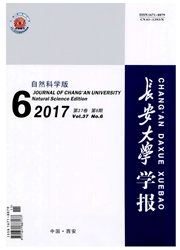

 中文摘要:
中文摘要:
在车联网环境下,车辆的移动改变了交通状态,继而触发网络连通性的变化,引发相关车辆对自身移动方式的调整。为了更好地挖掘真实的车辆移动轨迹,首先从车辆、交通情境以及驾驶人角度剖析包括移动约束、交通环境及时间尺度等影响车辆运动方式的关键元素,为构建模型提供指导;然后依据移动模型的数学理论方法,回顾了移动模型近年来的研究进展、代表性研究成果及相关文献等,并将其分为交通波模型、车辆跟驰模型、元胞自动机以及行为模型这4类;为了生成贴近真实状态的模型,采用真实数据对理论模型进行验证并修正;在阐述该方法的基础上,选取用户相关的数据与车辆轨迹数据对移动模型进行具体划分,并论述其在刻画物理环境、车辆交互、出行者习性以及反映交通流的实时状况,预测未来车流趋势等方面的应用。研究结果表明:现有模型对车辆属性与驾驶行为特性考虑较少,这会造成移动模型对车辆及驾驶人个体特征的忽略,从而影响模型的适应性;如何在特定的交通应用下,加强网络仿真器与车辆移动模型之间的交互,挖掘特色应用领域,实现人、车辆、交通环境之间的最佳匹配,将是车辆移动模型的未来发展方向。通过展望车辆移动模型的发展趋势,为该领域学者选择正确的架构模块和适当的模拟粒度提供参考。
 英文摘要:
英文摘要:
The traffic conditions would change when vehicles move under vehicular ad hoc networks (VANET). Then change of network connection was triggered which led to the adjustment of moving mode for related vehicles. In order to better investigate the actual vehicle moving trace, key factors influencing vehicle moving mode including mobile constraints, traffic environment and time scale were analyzed from the perspectives of vehicle, traffic situation and driver to provide a reference for the establishment of the model. Then the research development, representative research achievement and related literatures of the mobility model were reviewed according to the mathematical theory method. Four types of models including traffic wave model, car following model, cellular automation and behavioral model were presented. In order to generate a model truly reflecting the real estate, actual data were adopted to verify and modify thetheoretical model. Based on the method, mobility model was divided in detail by the selected related data of users and vehicle track, and the application of the method to the aspects such as real-time situations of physical environment, vehicles interaction, behaviors of users, real-time situation reflection for traffic flow and prediction for future traffic flow trend. The results show that the capability and driving behavior characteristics are less considered which leads to the neglect of the influence of mobility model on driver's personal characteristics, therefore the applicability of the model will be affected. How to enhance the interaction between network emulator and vehicular mobility model, discover feature application field to achieve the optimal match among users, vehicle and traffic environment are the research focus for vehicular mobility model. The prediction of the development trend of the model provides a reference for scholars in choosing correct architecture module and appropriate simulation particle size.
 同期刊论文项目
同期刊论文项目
 同项目期刊论文
同项目期刊论文
 期刊信息
期刊信息
